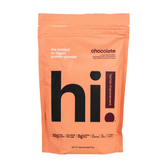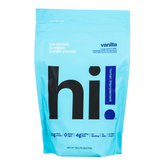“What actually is whey?”
Whey was discovered in the early 1970s as a byproduct of milk production [1]. Scientists figured out that they could isolate whey protein from the liquid run-off in the cheese making process, where cheese is made from milk.
Prior to its discovery, whey from cheese was nothing but a waste product disposed of into nearby lakes and rivers. When it’s potential for human nutrition was uncovered, whey was diverted to become whey protein: the protein source we know today.
Whey is still tied to traditional dairy and livestock farming and as the world is estimated to reach a global population of 10 billion by the year 2050 [2], we require more sustainable protein sources to meet the rise in demand.
To be sustainable, a protein source must meet our nutritional needs within planetary boundaries. In other words, a sustainable protein must be healthy for humans and for the planet.
Whey protein powder is a common protein source, but it's hard to digest and not sustainable
While whey protein powder is a complete protein source containing all of the necessary amino acids, those that are lactose intolerant can be sensitive if it is less processed [4]. In fact, whey has been known to cause bloating and gastrointestinal distress in many consumers.
Most whey protein products are heavily processed and isolated which strips out many of the natural vitamins and nutrients leaving just protein.
Production of whey protein remains dependent on the dairy industry, which is responsible for 16% of total agriculture greenhouse gas emissions in the United States [5].
Cricket protein powder is one of the most nutrient dense protein sources on the planet.
Cricket protein powder is both a protein and nutrient powerhouse. Per 100 grams, it packs around 60 grams of complete protein, 10 times your daily value of vitamin B12 and 25% your daily value of iron [ 6, 7]. It also contains prebiotic fibers like chitin and chitosan, nutrients not found in whey protein powder that help keep your gut microbiome healthy. It is a whole food protein source so it maintains the natural vitamins and minerals in a highly bioavailable form that are stripped out in protein isolates.
Cricket protein powder is also one of the most sustainable protein sources
Crickets are extremely efficient in converting food to protein compared to dairy cows and milk production. For example, crickets are around 60% protein, while milk is only around 3% protein [7].
Crickets also emit 99.9% less greenhouse gases, use 93% less water, and require 90% less land than livestock to produce the same amount of protein!
Despite the 2 billion humans that consume insects regularly today [8], many people living in Western and European countries are hesitant to add crickets to their pantry. The biggest culprit? People are skeptical about taste and texture.
Hi! (Human Improvement) has a better way to protein
By combining cricket protein with a blend of organic pumpkin, pea, and brown rice protein as well as other functional ingredients like flaxseed and psyllium husk powder, Human Improvement has created a one of a kind protein supplement. It is dairy-free, lactose-free, incredibly easy to digest, and high in B12, fiber, iron and many other vitamins and minerals all without any added sugar.
Not only is this a product that is incredibly good for you, it is also good for the planet.
Humans eating crickets at a global scale would be big news that packs a sustainable punch. But the majority of the human population won’t bite unless there is a tasty alternative.
This is where the mission at hi! comes in. We reimagined the entire protein powder experience and created a better way to protein. By incorporating sustainable ingredients and sustainable packaging, we created a product that is better for you and the planet.
Going beyond quality protein, hi! delivers a punch of micronutrients and fibers to support your overall health and well-being. Enjoy it in a smoothie, a latte, baked goods or however you protein.










